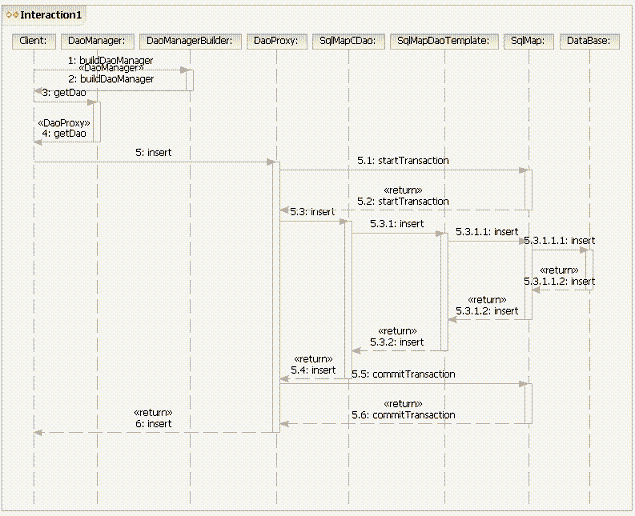iBatis DAO入門與進階(http://www.matrix.org.cn/resource/article/44/44058_iBatis+DAO.html)
?iBatis DAO事務探索(http://www.aygfsteel.com/RongHao/archive/2006/01/20/28817.html)
今天繼續研究了JPetStore的持久層,其中由于看了一篇文章的誤導,導致我對其中的事務處理深表懷疑。通過閱讀源代碼與看上面兩篇文章,對這個問題才認識清楚。和我當初預想的一致。
第一、持久層的研究
iBatis Dao的處理流程首先得到daoManager,它是通過文件配置的方式
配置文件為com.ibatis.jpetstore.persistence.dao.xml
 <transactionManager?type="SQLMAP">
<transactionManager?type="SQLMAP"> ??????<property?name="SqlMapConfigResource"
??????<property?name="SqlMapConfigResource" ????????value="com/ibatis/jpetstore/persistence/sqlmapdao/sql/sql-map-config.xml"/>
????????value="com/ibatis/jpetstore/persistence/sqlmapdao/sql/sql-map-config.xml"/> ????</transactionManager>
????</transactionManager>
 ????<dao?interface="com.ibatis.jpetstore.persistence.iface.ItemDao"
????<dao?interface="com.ibatis.jpetstore.persistence.iface.ItemDao" ??????implementation="com.ibatis.jpetstore.persistence.sqlmapdao.ItemSqlMapDao"/>
??????implementation="com.ibatis.jpetstore.persistence.sqlmapdao.ItemSqlMapDao"/>這個配置文件將被com.ibatis.jpetstore.persistence.DaoConfig.java 調用得到系統的daoManager,整個過程也就是一個工廠模式。得到了daoManger,通過它來統一管理對數據庫的操作。
為了使用ibatis的DAO對數據庫進行操作,
首先是定義了一批接口類,位于包:com.ibatis.jpetstore.persistence.iface 。然后是一批實現這個接口類,位于包:com.ibatis.jpetstore.persistence.sqlmapdao
這些所有實現類繼承與sqlMapDaoTemplate,如下:

 public?class?ItemSqlMapDao?extends?BaseSqlMapDao?implements?ItemDao?
public?class?ItemSqlMapDao?extends?BaseSqlMapDao?implements?ItemDao? {
{

 ??public?ItemSqlMapDao(DaoManager?daoManager)?
??public?ItemSqlMapDao(DaoManager?daoManager)? {
{ ????super(daoManager);
????super(daoManager); ??}
??}


 }
}
 public?class?BaseSqlMapDao?extends?SqlMapDaoTemplate?
public?class?BaseSqlMapDao?extends?SqlMapDaoTemplate? {
{
 ??protected?static?final?int?PAGE_SIZE?=?4;
??protected?static?final?int?PAGE_SIZE?=?4;

 ??public?BaseSqlMapDao(DaoManager?daoManager)?
??public?BaseSqlMapDao(DaoManager?daoManager)? {
{ ????super(daoManager);
????super(daoManager); ??}
??}
 }
}最后在業務邏輯層com.ibatis.jpetstore.service調用持久層完成對數據庫的訪問。

 public?class?OrderService?
public?class?OrderService? {
{
 ??private?DaoManager?daoManager;
??private?DaoManager?daoManager; ??
??



 ??public?OrderService()?
??public?OrderService()? {
{ ????daoManager?=?DaoConfig.getDaoManager();
????daoManager?=?DaoConfig.getDaoManager(); ????itemDao?=?(ItemDao)?daoManager.getDao(ItemDao.class);
????itemDao?=?(ItemDao)?daoManager.getDao(ItemDao.class); ????sequenceDao?=?(SequenceDao)?daoManager.getDao(SequenceDao.class);
????sequenceDao?=?(SequenceDao)?daoManager.getDao(SequenceDao.class); ????orderDao?=?(OrderDao)?daoManager.getDao(OrderDao.class);
????orderDao?=?(OrderDao)?daoManager.getDao(OrderDao.class); ??}
??} }
} <dao?interface="com.ibatis.jpetstore.persistence.iface.ItemDao"
<dao?interface="com.ibatis.jpetstore.persistence.iface.ItemDao" ??????implementation="com.ibatis.jpetstore.persistence.sqlmapdao.ItemSqlMapDao"/>
??????implementation="com.ibatis.jpetstore.persistence.sqlmapdao.ItemSqlMapDao"/>
然后通過這些實現類進行數據庫訪問操作。如在OrderService下:

 public?void?insertOrder(Order?order)?
public?void?insertOrder(Order?order)? {
{
 ????try?
????try? {
{ ??????//?Get?the?next?id?within?a?separate?transaction
??????//?Get?the?next?id?within?a?separate?transaction ??????order.setOrderId(getNextId("ordernum"));
??????order.setOrderId(getNextId("ordernum"));
 ??????daoManager.startTransaction();
??????daoManager.startTransaction();
 ??????itemDao.updateAllQuantitiesFromOrder(order);
??????itemDao.updateAllQuantitiesFromOrder(order); ??????orderDao.insertOrder(order);
??????orderDao.insertOrder(order);
 ??????daoManager.commitTransaction();
??????daoManager.commitTransaction();
 ????}?finally?
????}?finally? {
{ ??????daoManager.endTransaction();
??????daoManager.endTransaction(); ????}
????} ??}
??}其中還值得注意的是,在各個實現類中ItemSqlMapDao并不包含對事務的處理,所有對于事務的處理都是在業務邏輯層調用。這樣做的好處在于所有Dao的操作都是原子操作,方便進行各種業務邏輯的組裝。(以前,我設計時候,這個地方沒有設計好)
第二、事務處理的研究
此處涉及到了事務的處理,來分析一下事務處理的過程。
首先看一個事務處理的時序圖
從這張時序圖可以看到事務的處理是由代理類DataProxy完成的,查看DataProxy的代碼
 ?public?Object?invoke(Object?proxy,?Method?method,?Object[]?args)
?public?Object?invoke(Object?proxy,?Method?method,?Object[]?args)
 ??????throws?Throwable?
??????throws?Throwable? {
{ ????Object?result?=?null;
????Object?result?=?null;
 ????if?(PASSTHROUGH_METHODS.contains(method.getName()))?
????if?(PASSTHROUGH_METHODS.contains(method.getName()))? {
{
 ??????try?
??????try? {
{ ????????result?=?method.invoke(daoImpl.getDaoInstance(),?args);
????????result?=?method.invoke(daoImpl.getDaoInstance(),?args);
 ??????}?catch?(Throwable?t)?
??????}?catch?(Throwable?t)? {
{ ????????throw?ClassInfo.unwrapThrowable(t);
????????throw?ClassInfo.unwrapThrowable(t); ??????}
??????}
 ????}?else?
????}?else? {
{ ??????StandardDaoManager?daoManager?=?daoImpl.getDaoManager();
??????StandardDaoManager?daoManager?=?daoImpl.getDaoManager(); ??????DaoContext?context?=?daoImpl.getDaoContext();
??????DaoContext?context?=?daoImpl.getDaoContext();

 ??????if?(daoManager.isExplicitTransaction())?
??????if?(daoManager.isExplicitTransaction())? {
{ ????????//?Just?start?the?transaction?(explicit)
????????//?Just?start?the?transaction?(explicit)
 ????????try?
????????try? {
{ ??????????context.startTransaction();
??????????context.startTransaction(); ??????????result?=?method.invoke(daoImpl.getDaoInstance(),?args);
??????????result?=?method.invoke(daoImpl.getDaoInstance(),?args);
 ????????}?catch?(Throwable?t)?
????????}?catch?(Throwable?t)? {
{ ??????????throw?ClassInfo.unwrapThrowable(t);
??????????throw?ClassInfo.unwrapThrowable(t); ????????}
????????}
 ??????}?else?
??????}?else? {
{ ????????//?Start,?commit?and?end?the?transaction?(autocommit)
????????//?Start,?commit?and?end?the?transaction?(autocommit)
 ????????try?
????????try? {
{ ??????????context.startTransaction();
??????????context.startTransaction(); ??????????result?=?method.invoke(daoImpl.getDaoInstance(),?args);
??????????result?=?method.invoke(daoImpl.getDaoInstance(),?args); ??????????context.commitTransaction();
??????????context.commitTransaction();
 ????????}?catch?(Throwable?t)?
????????}?catch?(Throwable?t)? {
{ ??????????throw?ClassInfo.unwrapThrowable(t);
??????????throw?ClassInfo.unwrapThrowable(t);
 ????????}?finally?
????????}?finally? {
{ ??????????context.endTransaction();
??????????context.endTransaction(); ????????}
????????} ??????}
??????}
 ????}
????} ????return?result;
????return?result; ??}
??}根據這段代碼應該很清楚的知道Dao框架采用AOP模式,截獲所調用的方法,并檢查事務處理是否已經顯式的開始執行,如果沒有,它將調用事務管理器中的startTransaction()創建一個新的事務處理調用,然后執行被截獲的方法,然后commitTransaction。如果有,則直接執行所調用的方法。
所以,在此Dao框架下,所有沒有顯式的通過startTransaction調用事務的方法,都是一個獨立的事務。如果要想在一個事務中完成幾次調用,必須自己通過DaoMangaer手動處理事務。
至此,ibatis的JpetshopStore的持久層運行機制以及ibatis的Dao框架事務處理研究完畢。


